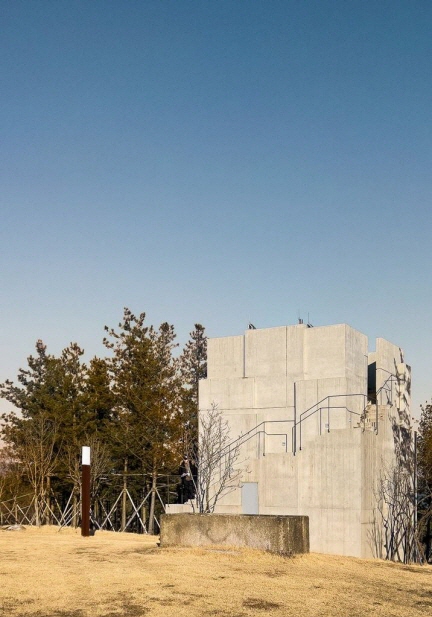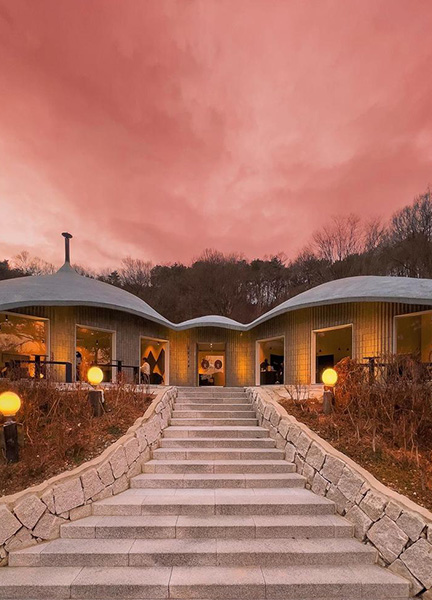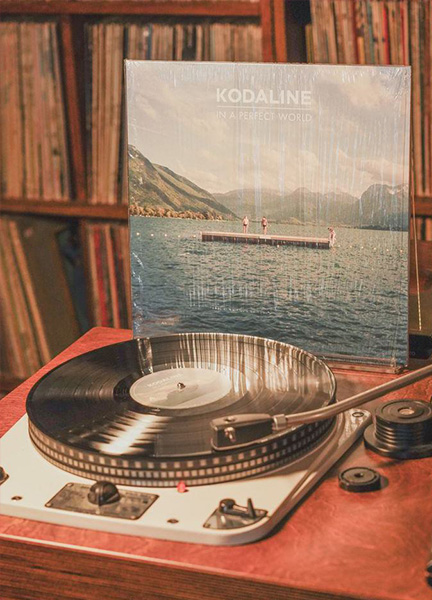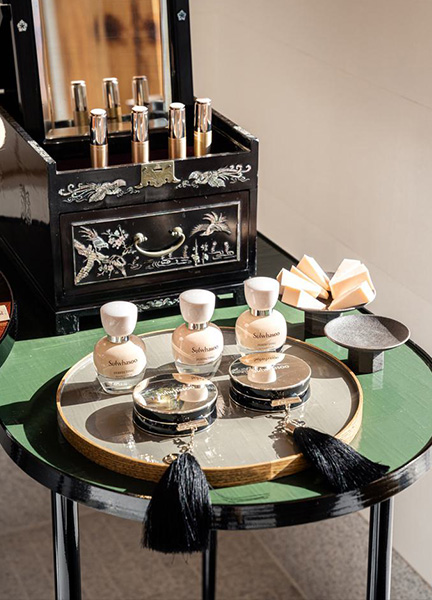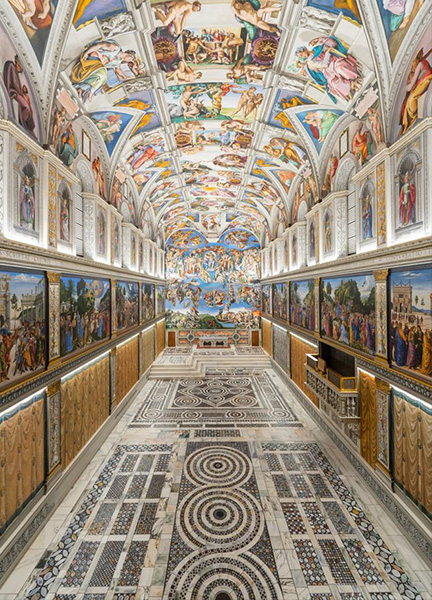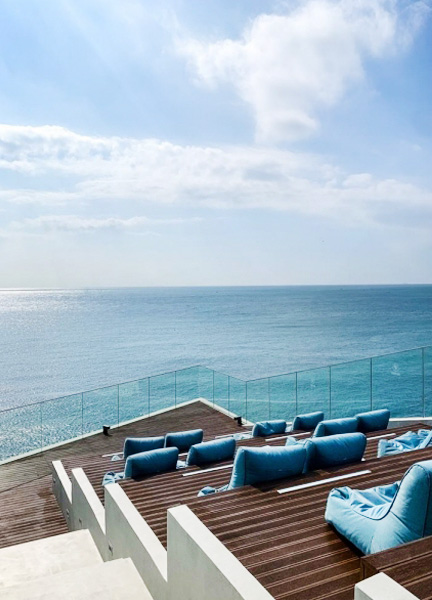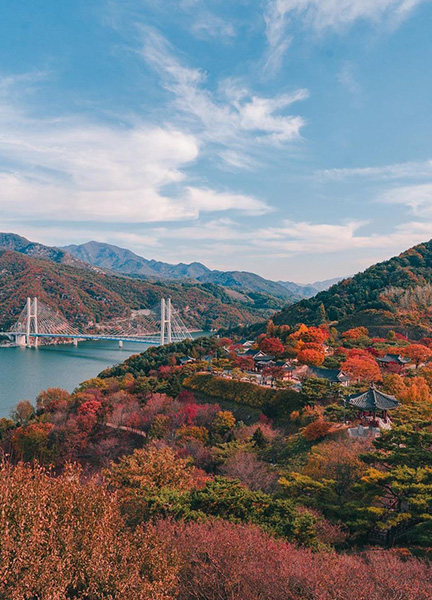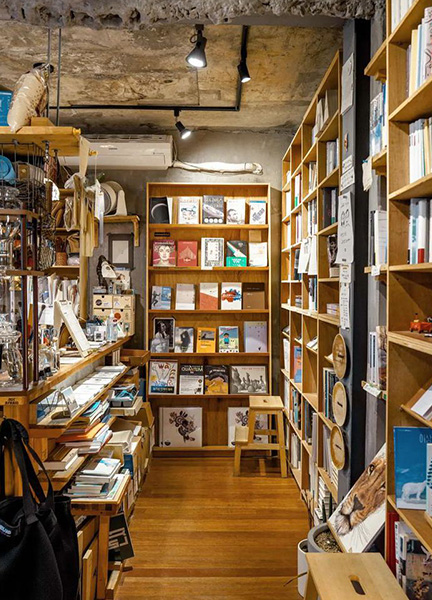the Coolest Places in Korea

13 Exhibition and Cultural Spaces to Enjoy Culture
- #Culture Complex
- # Cafe
- # Exhibition
- # Museum
@architechu
Beyond border
There are countless borders, and sometimes crossing them can leave a painful wound. It hurts enough to make us wince. Crossing the border of "time," "interpersonal relationship," and "inner self" can always cause such pain.
-
However, it is the pain that makes us move forward.
-
Until June 2017, I had someone in my life who was like air to me. He had a magical presence that could always bring joy. He was the first person I had ever trusted 100%. I speak of him this way now, but I wasn't like this in the past. I was a fool that didn't realize how precious the "air" was. I took him for granted and always believed he would stay with me. But that person passed away at the end of June. My desperate prayers in front of the emergency room were in vain. I had no idea at that time. I started to feel the pain due to his absence after six months had passed. I think I was in denial of reality. However, as I became aware of and crossed the border again, every moment of my life felt awkward. Being alive was so absurdly boring. I once promised, "Let's have fun for the rest of our lives!" But keeping the promise was not easy. Nothing was fun, and only fulfilling the promise of "standing on the side of the weak,", felt like a burden on my shoulders. His presence was never a given. He was so precious to me.
-
By witnessing the borders between myself and others and between life and death, I learned that we only realize what is most precious when it is gone. Since then, I have taken nothing for granted.
In 2018, I hoped that people would read my stories a lot. At that time, in order not to “spoil” readers’ experience with a certain space, I believed that taking photos of part of the space while providing written description would be sufficient. I wanted people to "feel" the space in their imagination, like reading novels, and go there and compare the reality with their imagination. However, things have changed a lot since then. I learned that people read text a lot less than I imagined. Nevertheless, I was grateful for those who did read, and I tried to gather strength. But one day, I realized that I was wrong. "Am I not utilizing the advantages of the media at all?" This question pushed me to cross the border I had drawn for myself. I decided to convey everything through "visual images," and to write more details. To encourage people to read the text, I started adding information about the space at the bottom of the text and attached a "menu" on the last page. Because I was desperate, I was able to create my own content format by crossing the line within myself. Looking back now, I think the format has already been in my head for a long time. However, I had drawn my limit because I thought people would be spoiled by my writing before even going there. So, it took quite a bit of pain to cross the border I had drawn within myself and take an action to complete the format.
This is how I crossed my own border and learned that we know nothing unless we experience the borders. Since then, I laid up the sentence "Only experience will reveal reality" in my heart and lived my life accordingly.
It is not always the case, but when we cross the border of "time," "interpersonal relationship," and "inner self," we often experience pain. That is why we try to find a way out of that pain and that’s how we move forward.
The space I will introduce today shows the borders well through experience.
Space is not a single mass, but a cluster of various masses. The borders between these masses do exist. Sometimes visual elements such as a long road highlight the border, or colored concrete and gray pebbles are laid on the ground to highlight it. However, people step on these borders without paying much attention to them. There are also borders between natural and artificial materials, but people cross these borders without hesitation and experience the interior and exterior spaces as they walk. Once you enter the exhibition hall of the space I’ll introduce today, the twin gardens and exhibition routes are deliberately designed to allow visitors to cross the borders of these masses. The exhibition is so vast that it takes more than 1.5 hours to see everything.
In addition, the exhibition offers the best way to enjoy this space. The exhibition enables us to continuously cross the borders of the masses and encounter new thoughts and scenes.
Central spaces that people frequently visit are usually in the shape of an ellipse. The ellipse means experience. During the Renaissance Era in Europe, "perspective" and "philosophy" developed, and ancient Europeans designed spaces in a priori* manner. One example is "perfect bilateral symmetry," so when one looks at the left side, one can assume the shape on the other side without going there. Plazas were squares or perfect circles. With this spatial arrangement, you can experience the same regardless of direction.
However, after that, the Rococo and Baroque movements emerged, and the space arrangement changed. Different statues were placed on the left and right sides of the building, and plazas were changed into an obliquely oval shape. The oval shape continuously provides different experiences depending on the oblique curvature of the ellipse as you walk.
-
As such, this oval-shaped courtyard sitting at the center of the space seems to deliver the message, "You will never understand this place unless you experience it."
In the end, space is about crossing borders and experiencing what matters. It's about "you have to experience the borders to understand them" and "how do we move forward?". The space is quite superb also from an aesthetical perspective. Geometric patterns continue and maximize the volume effects a single material can provide. The columns are not set squarely into the wall but are rotated 45 degrees to give them a more geometric pattern. The oval-shaped courtyard and a series of columns in the arcade sitting between the pine garden and the main space also create a rhythm to the space and provide visual fun in the geometric masterpiece. The combination of the green of the trees and the warm concrete color makes you feel like you're in an illustration. It's definitely a unique space that is rarely found in Korea.
I hope you have a hands-on experience with the space by stepping on the border between your life before and your life after experiencing this place, just like the message it conveys, instead of trying to analyze the experience offered by the space.
-
This is #mrnw in Daegu, where I learned about the borders.
-
"Scenes" you can witness at the space _ a coffee place, an exhibition place, a garden to enjoy taking a walk
-
*Priori_ The claim that humans have a subjective cognition that precedes experience. It is an epistemological stance that cognition of an object is innately possible without relations with the object. [Naver Korean Dictionary]
- Address: 300-22, Hoguk-ro, Buk-gu, Daegu
- Operating hours - Café: 10:00-21:00 / Exhibition: 12:00-19:00 (Last admission 18:00)
- Admission:18,000 won for adults, On-site reservations available
- Exhibition_
- Parking space available
- #Exhibition
@younggwangeee
The first exhibition at the Leeum Museum of Art in 2023
Free exhibition We by Maurizio Cattelan, one of the most controversial artists of this era.
-
The exhibition, the largest since Cattelan's 2011 retrospective at the Guggenheim Museum in New York, will feature 38 works covering the span of the artist's emergence on the art scene from the 1990s to the present day.
A majority of Cattelan's works are super-realistic sculptures and paintings that are straightforward to understand immediately. They are often influenced by certain styles in art history or cleverly exploit familiar pop culture elements.
Although the title of the exhibition, WE, was inspired from one of Cattelan's works, it asks us questions about who we are, how we become the people we are, and the nature of our relationships with others, rather than a direct reference to the artwork.
In Cattelan's work, "thoughts" about oppression, anxiety, authority, religion, love, me and my family, life, and death, and what it means to be "us" facilitate discussions and allow for some kind of solidarity.
You can see "Comedian," the world's most expensive banana taped to a wall that first appeared at the 2019 Art Basel Miami Beach, "The Ninth Hour," a sculpture of a fallen pope hit by a meteorite, and "All," a series of nine Carrara marble sculptures resembling corpses.
- Address: 60-16, Itaewon-ro 55-gil, Yongsan-gu, Seoul
- Exhibition period:
January 31 - July 16, 2023 - Operating hours: 10:00-18:00 (Closed Mondays)
- Visit the website for reservations
- (On-site reservations available) depending on the situation
- #Culture Complex
- # Cafe
- # Restaurant
- # Exhibition
- # Museum
@gongmyeong(공명)
A design-led microcosm in Incheon
It's the power of design. An abandoned chemical plant building that had lost its vitality after operating for a long period has been transformed into a cultural hub in the area. Behind the background of its ability to attract people like a magnet from afar lies a creative cultural will.
This is the story of COSMO 40, a culture complex located in Seo-gu, Incheon. It is one of the cases of transforming a former factory with art. The unique identity of the space and its concept that inspires users are notable. Let's explore the design microcosm that combines Incheon's past and present.
History
In the 1970s, Cosmo Chemical's factories were built on a site of about 76,000 square meters. When the company decided to relocate them to Ulsan in 2016, a majority of them spanning a 66,000 square meter area were demolished. Factory no. 40 was planned to be destroyed as well, but thanks to the residents' will to preserve the space and its cultural potential, the building has become its current form.
The building was extended with regenerative architecture to protect the environment and minimize waste. In particular, it was awarded the Grand Prize of the Incheon Metropolitan City Architecture Award in 2019 and the Excellence Award of the Korean Architecture Award.
Main Hall (First and second floors)
The ground floor, with a high ceiling (10 meters) and mezzanine areas, can host exhibitions and events. The light emanating from the columns dominates the space. The light changes colors and has the effect of dramatically highlighting the exhibits displayed here.
Hoist Hall & Community Hall (Third and fourth floors)
The third floor of the old factory is a large space that is 14 meters tall. The mechanical equipment that had been installed at that time remains, creating a majestic feeling. A bakery cafe is located here, offering food and beverages, including specialty coffee, craft beer, and others.
The fourth floor, which can accommodate up to 100 people, is suitable for gatherings and events such as seminars, conferences, and networking. It provides people with opportunities to enjoy cultural activities.
Art of Combination
The combination of an empty space where you can apply any concept and the ability to transform any space created a unique space. It's like a combination of "A" and "B," thus creating a whole new "C" by making up for each other's shortcomings.
A significant part of the "canvas," an empty factory, has been intentionally left unpainted. While necessary design elements were added, the blank space's unique feature was preserved to make it an expression in itself.
Upon entering this enormous "culture factory," you will encounter intersections of experiences as you discover design "treasures" throughout the space. Careful consideration was given to blending the past and present and deciding how much to reveal or conceal, resulting in a harmonious whole.
The architect's deep understanding of the space and exceptional development skills deserve high praise. COSMO 40, a great source of inspiration, continues to inspire people even now.
Architectural design - @lifethings.in
Construction – BOV Comprehensive Construction Company (Chang-bin Lee)
Interior design - @proof_n_partners / @sml_seungmo_lim
- Address: 9, Janggogae-ro 231beon-gil, Seo-gu, Incheon
- Operating hours: 10:00-20:00 on weekdays / 10:00-21:00 on weekends
- Inquiries: +82-32-575-2319
- Parking: Free parking is available for up to 2.5 hours when using the lounge. After that, a fee of 1,000 won will be charged for every additional 30 minutes.
- #Shop
@gongmyeong(공명)
An inclusive cultural plaza between land and sea
Once you enter a massive factory-like building through a dimly lit entrance, you will be drawn to a bright light at the center of a long hallway. Following your instincts, you will make your way toward the light. Although the entrance was on land, you will eventually find yourself in a large plaza facing the ocean, with the source of the light revealed. Along the way to the light and sea, the path is filled with various cultural experiences, including music, fashion, and food.
This is the story of MILLAC THE MARKET, which won the top prize at The Good Place Award 2022 and the grand prize at the Identity of Urban Architecture BUSAN. The building's exterior resembles a gigantic factory with an industrial-style interior design. You can enjoy the view of Gwangalli Beach here. It is an open plaza between the land and sea that brings together culture and people.
Trendy Market
Three buildings were connected to create a large interior space. The route is very simple, thanks to the straight passage sitting in the middle. You can conveniently look around here while experiencing various content, including restaurants, clothing shops, photo zones, etc. You can experience trendy brands, products, and display styles that are rarely found in department stores or outlets, including neon signs and soft indirect lighting. The building resembles a crowded marketplace, but you will see that it reflects the latest space planning and design styles.
Main Hall
Following the light at the center of the hallway will lead you to the main plaza, where people sit on terraced seats, enjoying food and conversation. The overwhelming sense of space and the thick rebar structure catch the eye. Exposed frames of the columns and ceiling emphasize the building's industrial image. You can enjoy the unique scenery within this architectural space.
Beyond the intersecting steel structures, you can see the sea. It's like a live video on a giant house-shaped screen. A movie theater has designated seats, but here you can move to any "seat" at any time, so you can conveniently enjoy the landscape. If you want to enjoy the sunlight, the lower seats are recommended, where you can enjoy various programs, including musical performances. Also, it is a great spot to watch the Busan Fireworks Festival.
Places offering both land and water landscapes are rich in cultural elements that can nourish our daily lives. Enjoying great spaces can lead to a more enriched life. To experience this, I recommend looking for and visiting places that have received local architecture awards or The Good Place Award, among others. It's important to seek out good feelings from various spaces. In the process of expanding and continuing your own experiences, you will find freedom, and in the results, you will find both big and small pleasures.
- Instagram: @millac_the_market_official
- Address: 56, Millaksubyeon-ro 17beon-gil, Suyeong-gu, Busan
- Operating hours: 10:00-24:00
- Inquiries: +82-51-752-5671
- Parking: Exclusive parking space available
- #Culture Complex
- # Cafe
- # Exhibition
- # Museum
@architechu
Water and wind are the guides
The purpose of the sculpture museum fits well with the area's name Wonam-ri, meaning a place with superior rocks. The sculptures here are made of stone and iron just like the area's name suggests. When you arrive here, you will easily notice that the rocky peaks surround a basin. This wide, low-laying place matches the characteristics of the rocks, harmonizing with the ground between the mountain ranges, giving a heavy feeling.
The art museum looks like one gigantic rock because it is surrounded by concrete walls in consideration of its windy location. Like the stone walls of Jeju Island, the walls enclose the center area while blocking or diverting the wind for human activities. At the same time, the huge boulders, some of which are taller than people, cover the space inside. Once you enter the museum by following the paths surrounded by the rocks, the exhibition space appears. The first thing you see is the sky through the cracks in the rocks over your head. Then you see the shining light and the sculptures. The floor is designed with rectangular shapes to allow visitors to enjoy the exhibits along the path conveniently. Step into the first space and appreciate the sculptures; you will be impressed by their beautiful curves. The curves create soft lines, but they also combine and create dynamics, like expansion and explosion. In such an honest space, the harmony of the works with smooth curves is beautiful, like a well-organized concerto. In addition, you will feel a breeze blowing over your head while appreciating this first space.
In fact, it's more like some unknown wind rustling the ceiling rather than feeling the air rushing past your head.
-
In the back of the space is a shallow stream rippling in the wind, diffusing light. The second space you will arrive at while following the path also exhibits sculptures made of stone and iron. What's different here is that the curves found in the works are alive. The rippling of the stream, stirred by the wind, is reflected in the sculptures. Sculptures that were already moving will look alive even more, thanks to the water, wind, and light.
If you become curious about the shallow stream, open the door, and you will see the shining rippling stream surrounded by the natural rock park and the concrete walls. This place faces west, so it is a great spot to see the greetings from the setting sun. The wind is held back by water here.
The impressive scene does not end at the stream but continues along the concrete boulder again. It leads naturally to the next exhibition facility and finally to the cafe. It's a natural path that doesn't have a period in the end but continues like a flow of air, inadvertently reaching its destination.
At first glance, the space looks like a huge concrete wall that strictly controls the direction of movement, but water and wind guide you as fluidly as their respective properties. In other words, the rocks are guardians, while the water and wind provide guidance.
-
The building does not go against the context of its surroundings, as if it were a shallow vessel to hold it.
-
Here, water and wind are the guides, and the rocks are the guardians. This is BAUZIUM SCULPTURE MUSEUM sitting on the rocks.
- Address: 37, Wonamoncheon 3-gil, Goseong-gun, Gangwon-do
- Operating hours: 10:00-18:00 (Closed Mondays)
- Admission: Adults 9,000 won (includes one Cafe Americano]
- Parking space available
- Scenes of the space [Program] _ Exhibition, Private House, Art Shop, Cafe
- #Culture Complex
- # Cafe
- # Restaurant
- # Exhibition
- # Tourist Destination
@pbysj
The ultimate manifestation of taste realized in space
SOUNDS URBAN RESORT HANNAM, which aspires to be an "urban resort," is a comprehensive spatial artwork that was created by JOH & Company. The design company has made unique achievements in all fields where people's tastes can be reflected, such as in magazines, restaurants, hotels, offices, and retail.
Capturing the "things that make us happy in urban life" has influenced this space. The best part is that the happiness is not just for the employees who work here, nor for the passersby. I admire the architect's empathy in including elements for both groups of people.
SOUNDS URBAN RESORT HANNAM comprises offices, a bookstore, casual and fine dining restaurants, bars, cafes, flower shops, opticians, Aesop, Dyson, galleries, auctions, and even convenience stores. At this point, the best way to describe it is, "We didn't know what you'd like, so we prepared everything."
While JOH & Company's "sensibility" is now an asset of Kakao, I think it has left an example to the industry that 'creativity with substance pays off' and has paved the way for a more multi-dimensional experience with tastes in the city center. It is a brand I will think of whenever I want to put something out into the world with my message.
- #Culture Complex
- # Cafe
@eenomsiki
"An awesome space, Bukhangang River view, coffee, and..."
AYU SPACE, a culture complex built by architect Byoung-soo Cho, generated buzz even before its opening. Now the space will officially open at the end of this month.
The circular structure at the center is empty. You can feel the unique ambiance created by the structure as you stroll around it. Called the VAYU , this area is a great place to enjoy coffee and conversations.
A door inside will lead you to a wide walkway and terrace along the Bukhangang River. The hanok (traditional Korean house) next to it will be used as a gallery exhibiting various artworks later.
If you come across a cafe in an impressive building on the outskirts of Seoul, you might be skeptical about the quality of their coffee. But, even if you order brewed coffee, coffees here boast superb quality.
This cafe offers guests a variety of in-house roasted coffee beans to suit their preferences and level of customization, including single-origin beans with distinctive characteristics. They come in three grades: general, Plus [+], and 2Plus [++].
General and Plus grade coffee beans are brewed using a brewing machine, whereas 2Plus beans are hand-brewed by the barista.
But don't worry. Even if you choose the automated brewing option, the cafe uses iRHEA machine with proven quality.
Awesome space, a gallery, Bukhangang River views
as well as tasty coffee, make this AYU SPACE a must-visit despite its relatively remote location on the outskirts of Seoul, which I don't frequently visit.
- Address: 71, Bukhangang-ro 1462beon-gil, Namyangju-si, Gyeonggi-do
- Operating hours: 10:00-21:00 on weekdays / 09:00-22:00 on weekends
- #Exhibition
- # Museum
@architechu
Water, Wind, Stone Museum episode 1: The humans meet nature
Dong-ryong Yoo is a Korean-Japanese architect who is more widely known as his penname Jun Itami. He maintained his Korean nationality until he passed away. He hurriedly made up his penname Jun Itami, because it was needed to create his own company in Japan. The name "Itami" originated from the name of the airport he frequently used to travel between Korea and Japan. The name "Jun" is said to have come from the Japanese reading of the letter Yoon in the name of the composer and his long-time friend Kilok Yoon.
He once said, "Architecture is about making life." He insisted that space always influences people, and I agree with him. That is why careful consideration should be made when creating a space as much as each person is precious.
-
The Water, Wind, Stone Museum, located in BIOTOPIA, is the work that Dong-ryong Yoo made in later years. It doesn't display any artwork. Instead, natural elements such as water, wind, and stone are exhibited here to symbolize the harmony of nature and space. Today, I would like to introduce to you the Water Museum.
-
I have been waiting for over a month to come here. Just like a college student waiting to sign up for classes, I had been on standby to reserve a ticket for the exhibition on the PINX BIOTOPIA website. Only around ten people per session, twice a day, get the chance to experience this space. I finally managed to make a reservation and arrived here on the day.
-
I finally set foot in the space that I had imagined so many times in my mind, wondering, 'What kind of space is it?' and 'What kind of feelings will I experience?' as I looked at pictures of it.
The heavy concrete and stone walls symbolize the stone walls that can be found everywhere in Jeju. I go around the heavy stone walls and enter the Water Museum, where the sky is displayed. The water reflects the sky. The gentle ripples on the surface of water, stirred by the wind, symbolize tranquility, and bring the water closer to its true state than when it is still. The sway of light and the sunlight shone from above -- I'm listening to the guide, but I don't hear anything. I'm just impressed by looking at the scene.
Here, as I walk around, I feel connected to nature. While taking a walk, I can see the sky's reflection on the water's surface. Through the light gathered in the space, I can sense the invisible light with my eyes and my whole body.
The stories of space depicted by the architect can be found here.
-
If you study or like spaces, this museum is a must-visit. It is also recommended for those who do not.
This is # Water, Wind, Stone Museum, a space that connects water to humans.
- Address: BIOTOPIA, 79, Sallongnam-ro 762beon-gil, Seogwipo-si, Jeju-do
- Parking space available
- Tour hours: 1st session 13:30, 2nd session 15:30 (Visit the website to check hours for seasons other than winter), Closed on Saturdays, Sundays, and holidays
- Reservation: waterwindstonemuseum.co.kr
- Admission: Adults 25,000 won, visitors with a disability 12,500 won, Jeju locals 12,500 won
- #Culture Complex
- # Library
- # Exhibition
- # Museum
@hesaidthat
ART LIBRARY OF UIJEONGBU, where you can give yourself one day as a gift.
ART LIBRARY OF UIJEONGBU is an art library located in Millak-dong, Uijeongbu. Since I often go to Uijeongbu, I have wanted to visit this library with my wife for a long time. Although I briefly visited there, the impression still lingers in my mind. The space was designed with an emphasis on practicality for users.
The main keyword of the art library is "connection." The library's high ceilings and low bookshelves allow impressive unobstructed views. The space design that maximizes the sense of openness adds to the library's attractiveness. The library has three above-ground floors and a parking lot on the first basement floor.
⠀
The first floor is the Art Ground, which consists mainly of art-related books on architecture, painting, crafts, and photography. The second floor is the General Ground, which has a clear purpose of serving as a space where both children and adults can have fun together. The Multi Ground on the third floor is a space for experience and community and has a cafe. The curated section called "Librarian's Collection" is very popular. Curation seems to be the most important keyword in any field these days.
⠀
The music suited for the ART LIBRARY OF UIJEONGBU is no music. When I review a space, I sometimes say that no music is the music that fits the space. ART LIBRARY OF UIJEONGBU is one such space.
- Address: 248, Millak-ro, Uijeongbu-si, Gyeonggi-do
- Operating hours: 10:00-21:00 on weekdays / 10:00-18:00 on weekends / Closed Mondays and public holidays
- Parking space available
- Kids zone, nursing room
- No pets are allowed
- #Exhibition
- # Museum
@_hyogeun_
“Jitda: Making”
-
The Korean word jitda describes the act of making, cooking, or building something essential to our lives, such as rice, clothes, or houses. As such, the Korean word encompasses tremendous effort and dedication.
We should think about the life of residents when we choose materials and structures. In the past, when selecting land to build a house, it had to be on a sunny hill because flatland should be used for rice farming. Likewise, understanding and interpreting the messages given by the land was more important than anything else and difficult, so more effort and care were required to build a house.
Reading and interpreting the land's messages was crucial to our ancestors because nature was not something to be tampered with. Unlike other countries that dig up the ground and damage nature to make it into their desired shape, traditional Korean architecture avoided stones and constructed two different buildings when faced with a stream. It did not build a house if it was to be constructed on a steep hill. They tried to understand the land instead of utilizing it; and thought nature was something to be feared and revered. Likewise, they tried to create harmony with nature in architecture. Therefore, continuously constructing a building that is naturally integrated into nature requires much effort and care.
Unfortunately, the Korean War devastated the country, and Koreans randomly "planted" buildings to recover quickly from the ruins rather than carefully building houses. Such random arrangement of buildings on the land, like pizza dough poked with a fork, led to apartments, villas, and commercial buildings with the same structure and layout. These recklessly constructed buildings caused stress, and that was when "SAYUWON" was created."
The spaces I encounter while walking in the mountains to reflect on and think about myself are all in harmony with nature. No matter how big or small the buildings are, how long or short they are, they become part of nature and welcome people.
We should consider the location of the trees, the height of the hills, and the view of nature we will see when we get there. The buildings and windows that are built after such considerations become “powerful” when they become part of the land.
SAYUWON is such a place.
The verb jitda in Korean is also used to refer to deciding on names. We make names to call someone, and calling someone is to understand him/her. To understand somebody, you need care and attention.
When parents make their baby's name, they hope their child will live like the meaning of the name. For this, they find and combine Chinese letters with good meanings and try to interpret what the name would mean. They also check the pronunciation of the name. Those with such a carefully selected name will have a unique identity that is differentiated from others.
The same goes for houses. When ancient Koreans built a house, they also named the house, inscribed it on a plaque, and hung the plaque on the house. The house's name was created hoping the owner's life would be like the house's name. Such names are nicer and more graceful than "Building A," "Building B," "Building 101," and "Building 102," and it makes you feel like the house is your own. Perhaps that's why calling our homes by their number, which lacks affection, has turned residential space into a place simply to sleep and a means to accumulate wealth.
-
Every building and road in SAYUWON has a name: Chi heo mun, Miradouro , So yo heon, Pung seol ki cheon yeon, Sa dam, Myeong jeong, Nae sim nak won, Cheom dan, O dang/Wa sa, Byeol yu dong cheon, Cho ha ru gil, Bi na ri gil, Ddak dda gu ri gil and more. These names are a combination of Chinese characters and Korean alphabets, each with a different meaning. The process of looking at the map, looking at the sign, looking at the plaque in front of the building, calling the name, and looking up the meaning is an implicit promise that the people who come to think, or sayu, will use the space as intended by the landlord.
Experience with different spaces according to the meaning written on the plaque will allow "thinkers" to escape the stress from the recklessly designed city buildings and take a good look inside themselves, asking 'Who am I?' 'Where am I going?' and 'Where should I go?' Here you can do the introspection you couldn't do properly in the busy modern society.
The synergy is immense when a house and its name become one and are built on the ground.
-
SAYUWON is such a place.
#A space for a good experience
- Address: 1150, Chisanhyoryeong-ro, Gunwi-gun, Gyeongsangbuk-do
- Reservations are required.
- #Library
@architechu
Hanok (a traditional Korean house) captures the seasons.
A hanok is in harmony with nature. There, you can hear water, wind, wind chime, and birds. If you want to enjoy the fall truly, visit here with a book and enjoy listening to the sound of turning its pages. You will discover the pleasure of reading and the beauty of autumn foliage.
Nowadays, it is not easy to listen to the sound of nature.
As of 2018, up to 91.8% of the population is living in cities. Do you frequently listen to the sound of nature? Most of us live in cities, where residential spaces are close to roads. Even if you open the window to let the wind come in, what you hear is the sound of cars and the noise of factories nearby. Let's think about what life was like for our ancestors.
Can we not simply return to living in hanok?
In short, the answer is “yes." There might be some clear gap with modern technologies, but living in a hanok is a viable option if you make some improvements. The hanok is an 'architectural style' that carefully considers seasonal changes. In particular, ondol (traditional floor heating system) is for winter, and daecheongmaru (flooring) and cheoma (eaves) are for summer. In addition, the hanok is a culmination of technology with many details that prepare for Korea's four seasons. At the same time, these hanok exude an idyllic atmosphere that is hard to witness at other spaces.
At the hanok, you can raise entire windows in the hot summer. The eaves cast shadows, and the open space allows the breeze to come in. And through those open windows, what you hear is not the noise of a city but the sounds of nature, bathed in the sunlight shining onto the spacious yard. This is possible because hanok are closely connected to the land. If you look at the layout of hanok that had been resided in by the noble class in a village, good ones are located on hillsides in the mountains. Social class differences can be one reason, but hanok sitting on higher ground resemble a modern penthouse. Ancient Koreans believed that houses built on higher ground, halfway up the hill more specifically, were good. A place closer to nature is secluded. Surrounded by forests, it is more nature-friendly and closer to the sound of nature rather than the noisy sounds of traditional markets. You will find this story more familiar if you've been to Hahoe Village and Yangdong Village.
Today's space is located on a hill in Inwangsan Mountain, where white clouds are hung. As I climbed the hill past Yoon Dong-ju Literary House, I saw a Khanok surrounded by forests in the mountains. I walked down the stairs to go there. It is situated on a concave terrain on a hill, so it feels stable and protected. And the moment I arrived there, I discovered myself surrounded by grand nature. I could hear the trees swaying in the breeze, and an awesome looking hanok with curved eaves greeted me, exuding a majestic presence.
I took off my shoes and entered the hanok. A soft breeze blew through the widely open doors. I saw trees and sunlight and heard the sounds of nature, particularly the sound of water dropping somewhere. I went there following the sound before I knew it. There's a small separate building at the very back of the space. It was barely big enough to fit four people around a table, and water was dripping outside the window. I reached into my bag and pulled out a book I had read in my spare time. Somehow, I felt like it was the ideal place to read.
I got lost in reading and realized that some people were waiting outside, so I had to leave the place. It was just for a few minutes, but it was a truly refreshing experience. The wind blew and rang the wind chime there. The sunlight was so bright, so I looked down and discovered that there was an underground floor at the hanok.
I went down to the underground floor out of curiosity. It was of a modern style but had a courtyard and a bamboo garden, considering the vertical connection to the hanok. This is a Korean literature library. Even though the size is small, the library consists of various rooms, each with a unique atmosphere. And an adequate number of people enjoyed reading in the rooms they chose. The sound of the wind rustling through the bamboo trees can be heard through the open door facing the garden.
Here you can hear the sound of nature.
It is recommended if you want to hear nature's sounds.
This is # Cheongun Literature Library located on Inwangsan Mountain, Jongno-gu.
- Address: 40, Jahamun-ro 36-gil, Jongno-gu, Seoul
- Parking space available [the parking space is small]
- Operating hours : 10:00-22:00 (Closed Mondays)
- #Nature
- # Library
@spot_editor
In autumn, the season of high skies, I recommend you visit a library of architectural beauty surrounded by nature and enjoy leisure hours reading books.
The YANGCHEON PARK BOOK SHELTER, which opened last November, won the Grand Prize at the 2021 Public Building Awards of Korea and the Excellence Award at the 2021 Seoul Architecture Awards.
The library's gracefully curved exterior along the round grass field is eye-catching. Inside the building, you will be amazed by the harmony of nature, relaxation, and humans.
You can witness the beauty of nature following seasonal changes -- lush green leaves, colorful autumn leaves, and the romantic snowscape, including white snow sitting on tree branches -- through the windows and folding doors. Enjoy some relaxing moments while reading books and appreciating beautiful nature.
The library is close to a park and a playground, so you can relieve stress while enjoying the outside views.
The beautiful architectural design of this space will be sufficient to arouse your interest in reading, even if you are not a bookworm. I think this is one of the beneficial functions of public buildings.
- Address: 111, Mokdongdong-ro, Yangcheon-gu, Seoul
- Instagram: @ycparkfriends
- On-street public parking lot available
- #Exhibition
- # Museum
@architechu
A pine tree hidden in the city
"There is no good architecture on Dosan-daero
"We looked at various buildings on Dosan-daero, but nothing inspired us," Jacques Herzog, 71, and Pierre de Meuron, 71, told reporters at the groundbreaking ceremony for the new SONGEUN ART SPACE building. They are a world-renowned architectural duo who have known each other since kindergarten. The duo, who were adamant throughout the interview, raised the need for an inspirational space in Dosan.
They are right. Dosan area is overcrowded with commercial buildings. This Dosan area, including Sinsa and Apgujeong, is a commercial area. As you already know, this expensive urban district is filled with luxury stores. Then doesn't it have any non-commercial public space at all? There are several high-rise buildings here. For a high-rise building to be built here, it should have an open public space, according to the law. Furthermore, if a building has a gross floor area of more than 10,000 square meters, part of the building's cost must be spent on art. If you look at these regulations alone, you would expect to see many open public spaces in Dosan, Gangnam, and Apgujeong, but it's hard to find such spaces. Even if you find some cases, they lack practicality, critically speaking. I doubt whether they are working as effective open public spaces, probably because they are more of an access road to the buildings or were designed for the convenience of those using them. I discussed this when introducing Brickwell in Seochon [see #A well in a city that captures the sky].
A city should provide diverse experiences.
Whether it's a commercial space you encounter on the street or an event in a public space you coincidently discover, a city that actively offers such experiences will be a more pleasant place to live. So, I believe a city should have various programs. In addition, these programs should be provided for free. If you had to pay for every experience in a city, would it be fun? Of course, rich people are more likely to have abundant experience and fun. But others find it hard to enjoy any benefit of living in a city even if they work, pay taxes, and walk on the pavements built with taxes they paid. In that sense, the law is necessary and should have clear effectiveness.
Then, is there an effort for this? If Brickwell in Seochon was the case in the past, the new SONGEUN ART SPACE building is the recent case.
The building emphasizes its open public space from its entrance. This open space leads to the back of the building, next to the beautiful terrace. In addition, uniquely designed terrace-type outdoor stairs go along the spiral stairs on the first floor inside the building. They are divided by thin glass walls, so it looks as if the whole first floor is an open public space. There is nothing more than an information desk on the first floor. The gallery area encompassing the second and third floors and the B1F exhibits the works of promising new artists identified by Songeun Art and Cultural Foundation and works of renowned artists under the theme of the building. The first exhibition you see is that of H&dM about the process and intention of the building's design, and their past work. The exhibition is organized under the theme of this new building. I have no doubt that this building, a work of art, should be on top of the exhibition list because it made me want to spend the whole day exploring the city around it. This is also a benefit offered by the city because it encouraged me to do event-like activities. Finally, the city's large-scale artwork is standing tall, and the experience offered inside the building is more artistic and public than commercial.
Maybe this building is truly a hidden pine tree (meaning of the word songeun). I heard the architect duo covered the entire building with a concrete surface that resembles the patterns of pine boards. But the building's image as a gigantic tree made me think of the building's name meaning.
Imagine a huge pine tree in the middle of a city, as tall as a skyscraper. Wouldn't it become one of the most beloved places in the city? The building reminded me of a gigantic tree that frequently appears in a legend playing a crucial role. Likewise, this building's beauty as a work of art and public space echoed in my heart.
I think we have a good space in Seoul, as claimed by the architect duo.
-
Even though I couldn't meet them in person, I would like to thank them for the fact that I could see their work in Korea. Even from a neutral perspective, putting aside my personal preference, this building’ significance will last for 100 years to come.
I hope the building will become a cultural and art hub in Dosan, as the architect duo hoped.
-
It is #SONGEUN ART SPACE, a hidden pine tree in Dosan.
- Free admission [Naver Booking]
- Address: 441, Dosan-daero, Gangnam-gu, Seoul
- Parking space available; Make sure to look at the parking space. [photo no. 09]
- Design _ Herzog & De Meuron















































































































